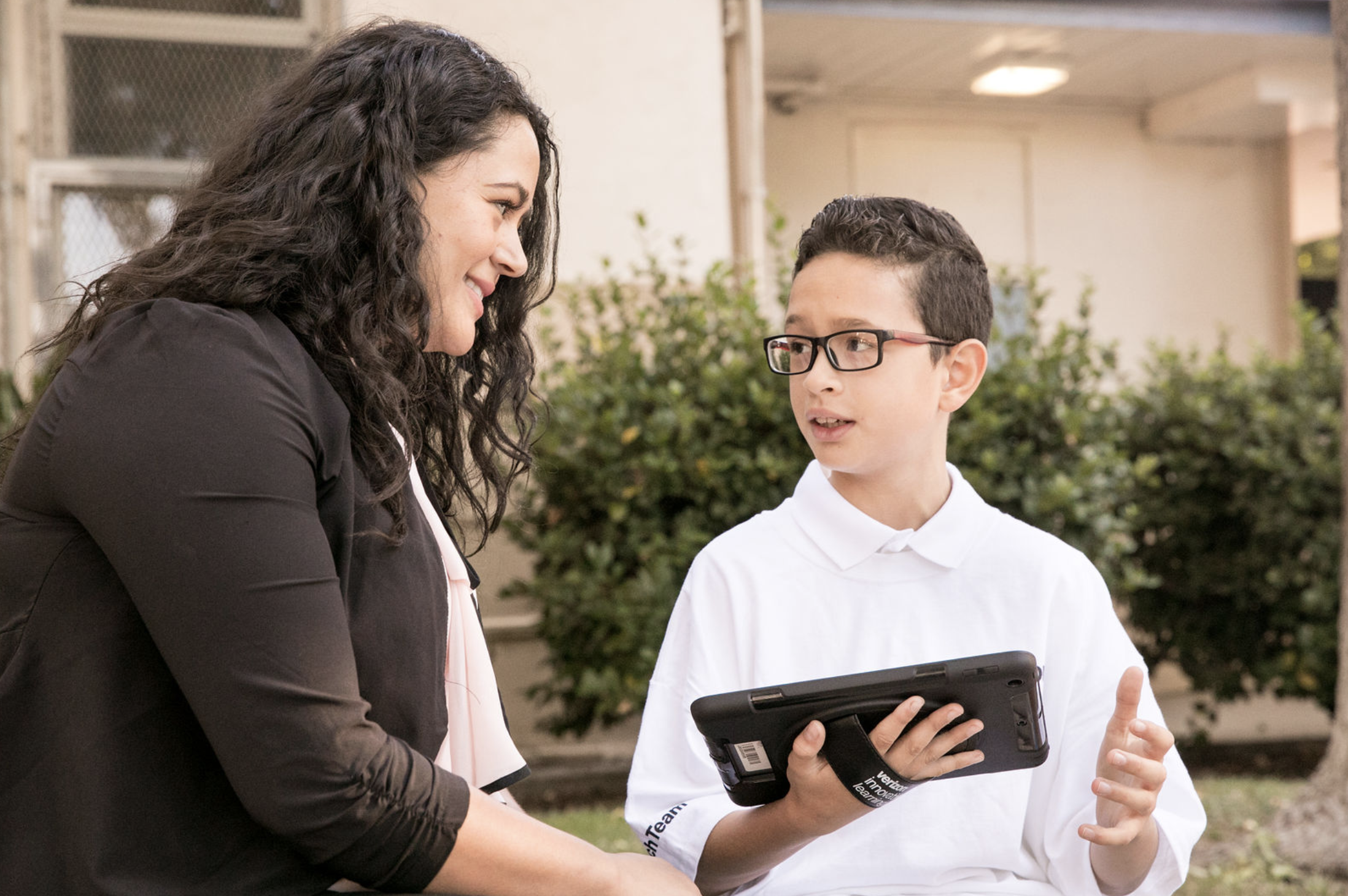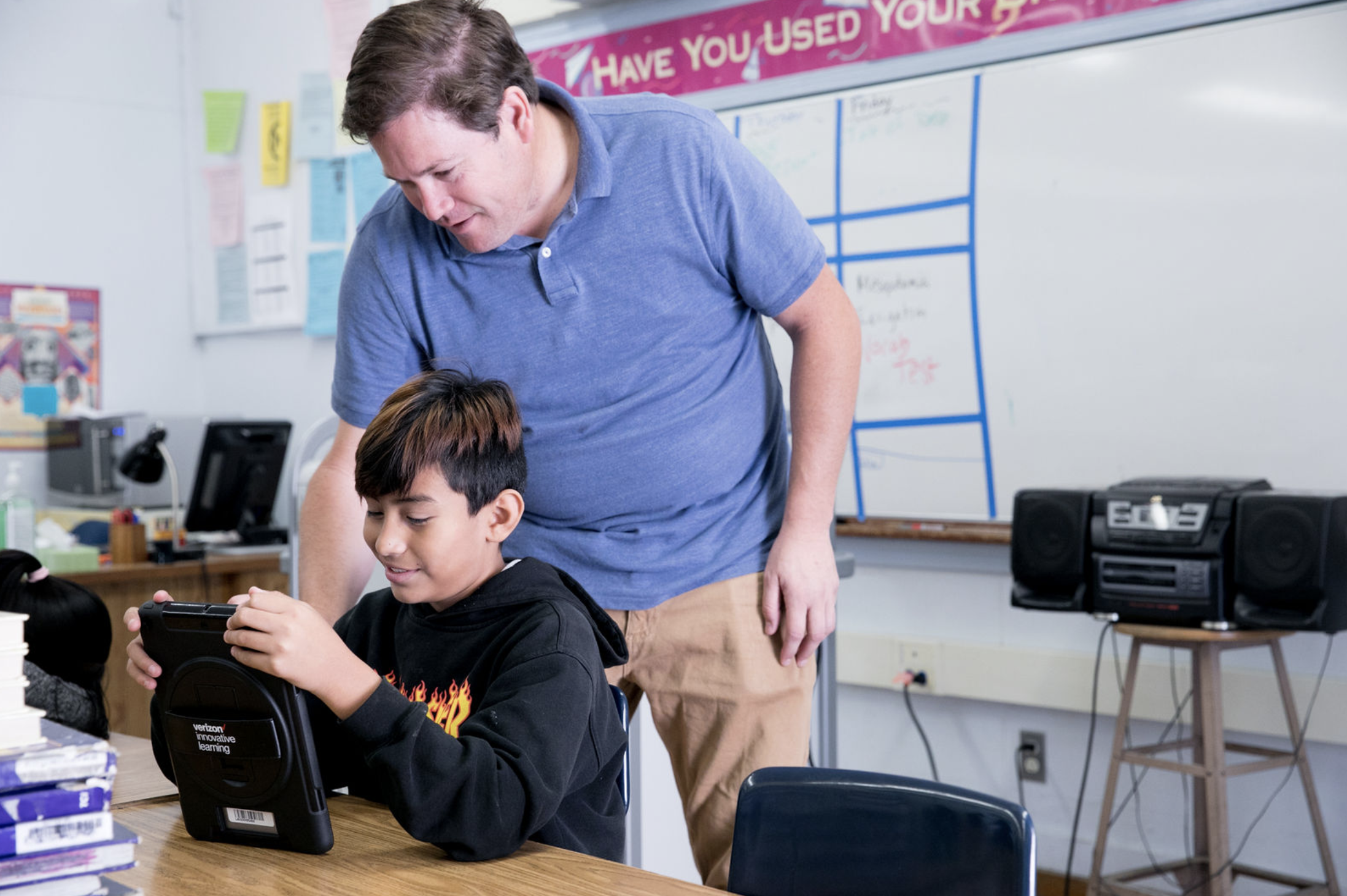Preparing
for a digital
future.
Verizon gives California middle
school students the tech they
need to thrive in the digital
economy.
(Photos: Ross Oscar Knight)
Exploring new possibilities, with tablets in hand.
On this crisp September morning, Danna Moreno-Rodriguez is considering storylines for a new video game. “I want to make an adventure game,” says the sixth-grader gleefully, eyeing her brand new tablet and imagining the possibilities. Until now, Danna has only been able to explore digital animation and computer coding at school, in her computer class – but all that is about to change.
Today Danna and each middle-schooler who attends John A. Sutter Middle School in Los Angeles is being issued a free tablet with 24/7 internet access as part of Verizon Innovative Learning. The program will be transformative for Sutter students, in school and beyond.
This program is about more than just going digital; it’s about leveraging technology to improve classroom instruction and engagement. Verizon Innovative Learning trains teachers to integrate the one-to-one technology in ways that are creative, that add value, and that have been shown to improve student engagement and academic performance. All that preparation was on display on the day of the device rollout, where Sutter students were taking earth science quizzes, Jeopardy-style, in class. Others were learning to create multimedia book reports, or steering sphero balls through the school gym – their engineering teacher offering guidance and encouragement as they did.
“I can feel the energy. I can feel the motivation.”
Since 2012, Verizon has been working to help close the digital divide through a transformative program called Verizon Innovative Learning. The program provides free tech, free internet access and a next-gen, technology-infused curriculum that changes the way teachers teach and students learn.
And it’s making a difference by driving real academic improvements: 54% of Verizon Innovative Learning students are more engaged in school and 58% of students were more proficient in STEM.* To date, Verizon has helped more than a million kids get the technology they deserve and is committed to helping 2 million more by 2021.
As the tablets are distributed to the students, the school’s marching band performs in the courtyard and students giddily show off their new tablets to peers and teachers. Parents and district leaders at Sutter for the event note that palpable excitement. As a local district superintendent, Joseph Nacorda, put it: “I can feel the energy. I can feel the motivation. This is something that’s absolutely important to them.” We spoke with several of the students and administrators about what this day, the new technology and access meant to them.
*Source: Westat (2018). Verizon Innovative Learning Schools – First Analysis of Student Administrative Data From Cohort 3 Schools.
(Photos: Ross Oscar Knight)
Preparing students for high school and beyond.
Sixth-grader Xavier Arce is a member of Sutter’s new, highly selective tech team, for which interested students must apply and provide teacher recommendations. Those selected help their peers and teachers operate devices and troubleshoot technical issues. It’s a position he relishes, explaining: “I’m really good at tech. It relaxes me, it calms me, and it makes me feel like a teacher.”
Like everyone on the tech team, Xavier got his tablet about a week before the rest of the student body. He immediately sensed it was a big responsibility, but one he was up for. “I feel like they must have trust in me,” he says. “It’s like a baby, you can’t lose it.”
On the day of the rollout, Xavier, 10, helps other Sutter students set up their devices. He is eager to show them some of his favorite applications, including one that makes math so much fun that he thinks even students who “don’t like math” will be sold.
For Xavier’s mother, who is selling donuts to support the parent-teacher association during the rollout event, Verizon Innovative Learning is preparing Sutter students for high school, for college and for the workplaces of the future. “That’s where we’re headed,” she says. “Everything is about technology now.”

(Photos: Ross Oscar Knight)
With expanded access to tech, students are free to extend their education.
Eight-grader Crystal Pacheco lights up when she discusses the dog wheelchair that her engineering class is developing. They will use their tablets to share sketches and numerical formulas to perfect their final product, which they will create with a 3D printer and a laser cutter.=
“All my projects are team projects,” Crystal’s engineering teacher, Maria Sklar, explains. “If half the team doesn’t have WiFi communications, that’s a problem; if the whole team has WiFi communications” – as all students now do, thanks to Verizon Innovative Learning – “they can continue working beyond the school day.”
Prior to the rollout, Crystal – who is in the school’s gifted program and is a leader of its Kind Club, which organizes service projects in and beyond the school community – didn’t have easy access to technology at home. She either had to complete her work in school or wait until the next day. That’s all changed now. “You don’t have to rush to finish your work,” she says. “You can take it home. You can proofread.”
With technology increasing engagement and giving students the ability to continue working – and finesse their work – beyond the school day, Sutter Principal Kelly Welsh says she expects to see students submit increasingly polished assignments.
(Photos: Ross Oscar Knight)
Excited by the chance to create.
Just as some students are excited to show off the math applications available, Laura Adlay, 11, relishes learning how to create a multimedia book report using a storytelling application that her sixth-grade English class is learning hours after receiving their tablets.

It allows them to take still photographs, and bring them to life through animation. “Some kids don’t know how to draw, and now they don’t need to feel bad about it,” says Laura, an aspiring artist, teacher, and baker.
For her book report on “The Girl Who Swallowed the Moon,” Laura plans to take a photo of the moon, give the moon eyes and a mouth, and have that moon narrate the synopsis of the book, which imagines the lived experiences of the women of Greek mythology. She says she’s “most excited about being able to take home projects and finish them in my home.”
(Photos: Ross Oscar Knight)
Giving students the freedom to work beyond the classroom.
“This age group has a lot of energy, but they are easily distracted,” Sutter Principal Kelly Welsh explains. “Engagement is key.”
Internet-enabled technology goes a long way toward that end, she says – thanks to mathematics and coding applications that Sutter students love, thanks to cameras, recording devices and video-editing software that revolutionize the way children learn, communicate and connect.
“We talk about kids being isolated in technology,” Welsh says, “but if I’m at home and can’t reach out to teachers or classmates, I’m the one who’s isolated if I can’t do that. The kid without a device is locked out of the conversation.”
Before Verizon Innovative Learning, many Sutter students had limited access, or none at all, to Internet-enabled devices in their homes. As a result, Welsh says, “it was slowing down instruction.” When all students have the ability to get online 24/7, teachers can cover more material in school – assigning additional online reading or video tutorials for homework. It also “builds in remediation and the time and support for individualization,” since students can work independently at their own pace.
(Photos: Ross Oscar Knight)
Exploring on their own, “beyond just what’s in the book.”
Her new tablet will allow seventh-grader Moniq Garcia to work at her own pace, and to be guided by her own intellectual curiosity. Moniq, who recently moved to the Los Angeles, from Houston, Texas, explained: “We can learn the ins and outs of a subject, not just what they give us.” Even the best textbooks can be limiting because you’re bound by what’s on the page. That’s the benefit of an internet-enabled tablet, the 12-year-old explains, rattling off the names of various educational applications.
Before Verizon Innovative Learning came to Sutter, Moniq’s only internet access at home was through her phone. Moniq, whose favorite subjects are science and writing, is now able to send herself digital reminders about homework assignments, and she has access to the school’s learning management system and, thus, her classwork wherever she goes. “It’s going to help [with] research beyond just what’s in the book,” Moniq says.
(Photos: Ross Oscar Knight)
Helping ESL students learn English while giving them a voice.
Hazel Henriquez eyes the line in the library where the tablets are being issued. It is long, and the seventh-grader fears that by the time she gets to the front, the devices will all be spoken for before she realizes there are enough to go around. As soon as Hazel, 11, receives hers, she uses the device’s camera and editing software, and she begins to “make a scary movie before Halloween.”
Hazel arrived in the United States two years ago, from El Salvador, and is an English-language learner. She has no computer at home, and before Verizon Innovative Learning came to Sutter, Hazel and her sister shared a single tablet – making it hard when both had homework assignments that they needed to complete.
She’s optimistic that having a tablet of her own will make things easier on that front, and also that it will go a long way to boosting her language skills. “I want to learn English this year,” Hazel, an aspiring lawyer, says. “I want to do homework in English.”
Sutter teacher Evelyn Huerta says technology can make a big difference for students who are learning English as a second language. When they first come to class, many are very timid, and “the teacher doesn’t know if [they’re not participating] because they don’t know the answer or they don’t know a word,” Huerta says. But easy access to translation applications “makes them feel like they have a voice.”

(Photos: Ross Oscar Knight)
With increased connectivity, “these kids are going to the moon.”
“I’m excited to see Verizon bring connectivity from class to home, from home to class, and from home to the rest of the world,” says Austin Beutner, in between engaging students, parents, and teachers on the morning of the rollout.
Beutner is superintendent of Los Angeles Unified School District, the nation’s second-largest school system. He says he’s gratified that many of the parents in attendance at the event seemed as excited as their children for the opportunities one-to-one technology provides.
“You see this burst of creativity in storytelling. You see students put together a portfolio of their own journey, and it’s more than just words and numbers on a page,” he says. As their access to information expands, it’s pictures, it’s music, it’s more.
“I think these kids are going to the moon,” he says.
